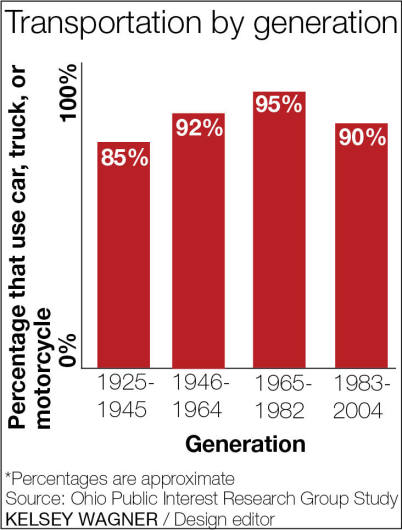More millennials have been delaying getting their driver’s license compared to previous generations, opting to use alternate transportation methods, and a new transportation and parking plan at Ohio State is set to help further accommodate this lifestyle change.
In the October study “Millennials in Motion,” conducted by the Ohio Public Interest Research Group, researchers found the average amount of miles driven by 16- to 34-year-olds decreased by 23 percent between 2001 and 2009 because of fewer trips and more diverse transportation options.
The study also stated that, according to data from the AAA Foundation for Highway Safety, the percentage of high-school seniors who have a driver’s license dropped to 73 percent from 85 percent between 1996 and 2010. The study said federal data suggests the decline has continued since 2010.
Many factors might have influenced the observed trend of millennials favoring alternative transportation to driving, the study said, including socioeconomic shifts, lifestyle preferences, and changing technology and transportation options, some of which have become more easily accessible and more user-friendly for the people who use them.
At OSU, alternative means of transportation have become popular among students in particular.
OSU has seen increases in the number of Campus Area Bus Systems riders, which rose to 4.9 million riders in 2014 from 3.9 million riders in 2012, said Justin Moss, a spokesman for OSU’s Department of Administration and Planning, in an email.
The number of bicycles on campus has also increased by 1 percent and is expected to continue to increase, especially after new residence halls on North Campus open and more students are living in that area of campus, Moss said.
Moss added that OSU plans to accommodate and encourage the increased use of alternative transportation through the Comprehensive Transportation and Parking Plan. The university’s transportation plan aims to expand on existing shared roads and shared-use paths to create an all-inclusive bicycle network, including additional connections to the Olentangy Trail system.
“(The goal is) to expand and create a clear and safe system for bicyclists to move through campus and connect to regional networks,” he said.
Moss said OSU plans to accomplish this through a combination of shared roads, bike lanes and shared-use paths.
“Research shows there have been mixed results with the safety of bike lanes and, as such, we have only recommended these in locations that tie into a city bike-lane system. We are considering all factors, including cyclist and pedestrian safety,” he said.
Also part of the CTPP is the proposed Campus Core Circulator, which would provide transportation around the core of campus, Moss said. The suggested plan would connect the areas where many students go while providing alternatives to driving through campus. As the idea is further developed, options such as specific routes and stops will be discussed by the university.
Students, however, have mixed reactions to peers using public transportation more regularly and getting their licenses later than previous generations.
Nathan Gammella, a fifth-year in architecture, got his license in high school and uses a mix of his own car and Central Ohio Transit Authority, the city bus system, while in Columbus. He said getting a license in high school can be helpful for teens and parents.
“I was able to drive myself to high school and take a lot of pressure off my parents,” he said.
Madison Graham, a first-year in neuroscience who got her license at 16 but has used public transportation more since coming to OSU, said she can see both sides to the choice to get a license.
“(I think) it’s kind of smart (to wait) in a way because at 16, you’re kind of stupid and not really ready to operate a vehicle,” she said. “But in a way, it’s good to start you out on (driving at an early age).”



